tire type MAZDA MODEL MAZDASPEED 6 2006 Owners Manual (in English)
[x] Cancel search | Manufacturer: MAZDA, Model Year: 2006, Model line: MODEL MAZDASPEED 6, Model: MAZDA MODEL MAZDASPEED 6 2006Pages: 354, PDF Size: 6.5 MB
Page 44 of 354
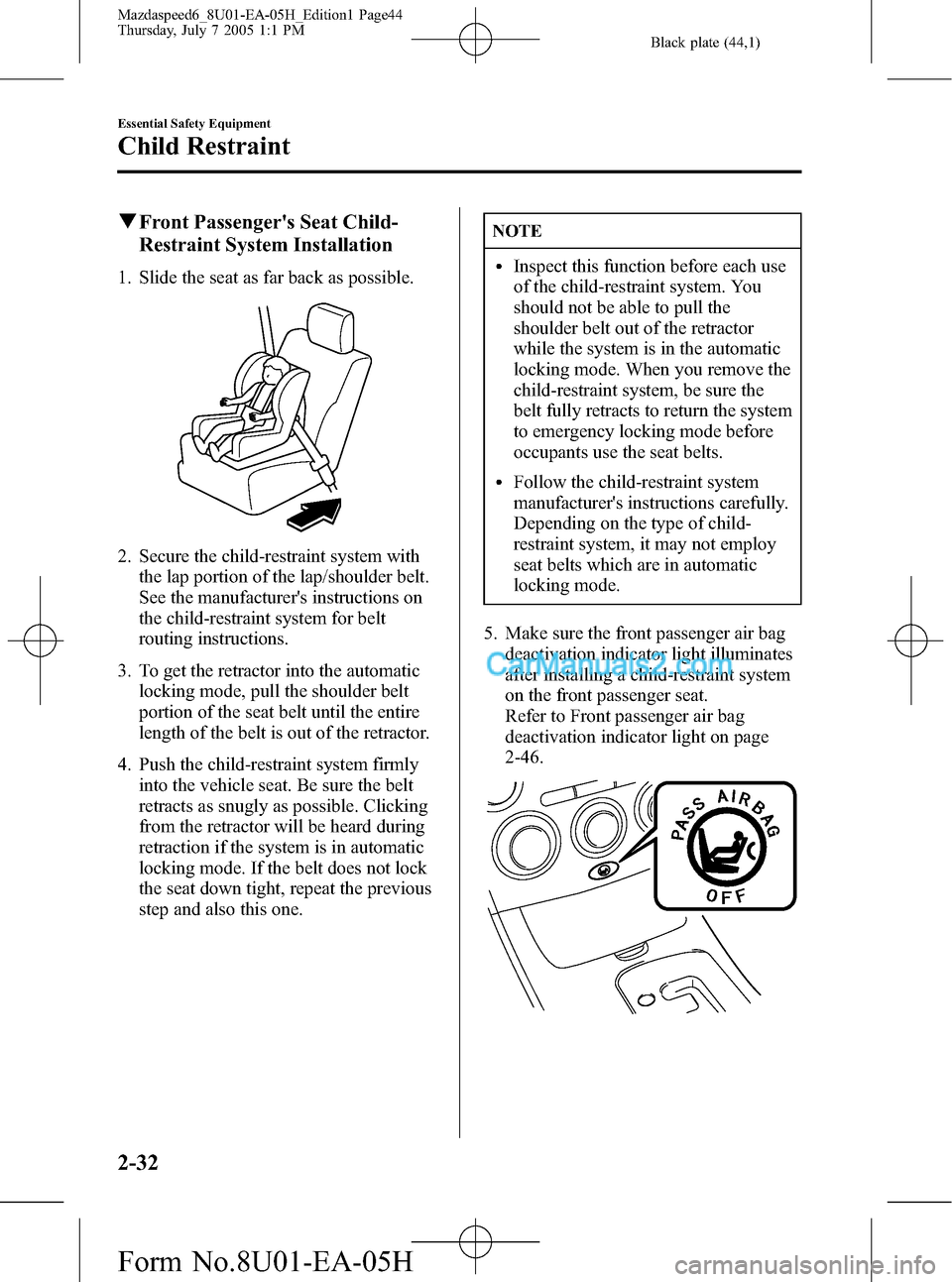
Black plate (44,1)
qFront Passenger's Seat Child-
Restraint System Installation
1. Slide the seat as far back as possible.
2. Secure the child-restraint system with
the lap portion of the lap/shoulder belt.
See the manufacturer's instructions on
the child-restraint system for belt
routing instructions.
3. To get the retractor into the automatic
locking mode, pull the shoulder belt
portion of the seat belt until the entire
length of the belt is out of the retractor.
4. Push the child-restraint system firmly
into the vehicle seat. Be sure the belt
retracts as snugly as possible. Clicking
from the retractor will be heard during
retraction if the system is in automatic
locking mode. If the belt does not lock
the seat down tight, repeat the previous
step and also this one.
NOTE
lInspect this function before each use
of the child-restraint system. You
should not be able to pull the
shoulder belt out of the retractor
while the system is in the automatic
locking mode. When you remove the
child-restraint system, be sure the
belt fully retracts to return the system
to emergency locking mode before
occupants use the seat belts.
lFollow the child-restraint system
manufacturer's instructions carefully.
Depending on the type of child-
restraint system, it may not employ
seat belts which are in automatic
locking mode.
5. Make sure the front passenger air bag
deactivation indicator light illuminates
after installing a child-restraint system
on the front passenger seat.
Refer to Front passenger air bag
deactivation indicator light on page
2-46.
2-32
Essential Safety Equipment
Child Restraint
Mazdaspeed6_8U01-EA-05H_Edition1 Page44
Thursday, July 7 2005 1:1 PM
Form No.8U01-EA-05H
Page 135 of 354

Black plate (135,1)
Winter Driving
lCarry emergency gear, window
scraper, flares, a small shovel, jumper
cables, and a small bag of sand or salt.
Ask an Authorized Mazda Dealer to
perform the following precautions:
lHave the proper ratio of antifreeze in
the radiator.
Refer to Engine Coolant on page 8-15.
lInspect the battery and its cables. Cold
reduces battery capacity.
lInspect the ignition system for damage
and loose connections.
lUse washer fluid made with
antifreeze―but don't use engine
coolant antifreeze for washer fluid
(page 8-19).
lDon't use the parking brake in freezing
weather as the parking brake may
freeze. Instead, shift to 1 or R and
block the rear wheels.
qSnow Tires
Use snow tires on all four wheels
Don't go faster than 120 km/h (75 mph)
while driving with snow tires. Inflate
snow tires 30 kPa (0.3 kgf/cm
2, 4.3 psi)
more than recommended on the tire
pressure label (driver's door frame), but
never more than the maximum cold-tire
pressure shown on the tires.
Your vehicle is originally equipped with
summer tires designed for optimum
traction on wet and dry roads. If your
vehicle is to be used on snow and ice
covered roads, Mazda recommends that
you replace the tires originally equipped
on your vehicle with snow tires during the
winter months.
WARNING
Mixing Tire Types:
Using tires different in size or type is
dangerous. Your vehicle's handling
could be greatly affected and result in
an accident. Use only the same size
and type tires (snow, radial, or non-
radial) on all four wheels.
CAUTION
Check local regulations before using
studded tires.
qTire Chains
This vehicle cannot be operated with tire
chains because it could cause interference
with the vehicle body and scratching.
Before Driving Your Mazda
Driving Tips
4-9
Mazdaspeed6_8U01-EA-05H_Edition1 Page135
Thursday, July 7 2005 1:2 PM
Form No.8U01-EA-05H
Page 150 of 354
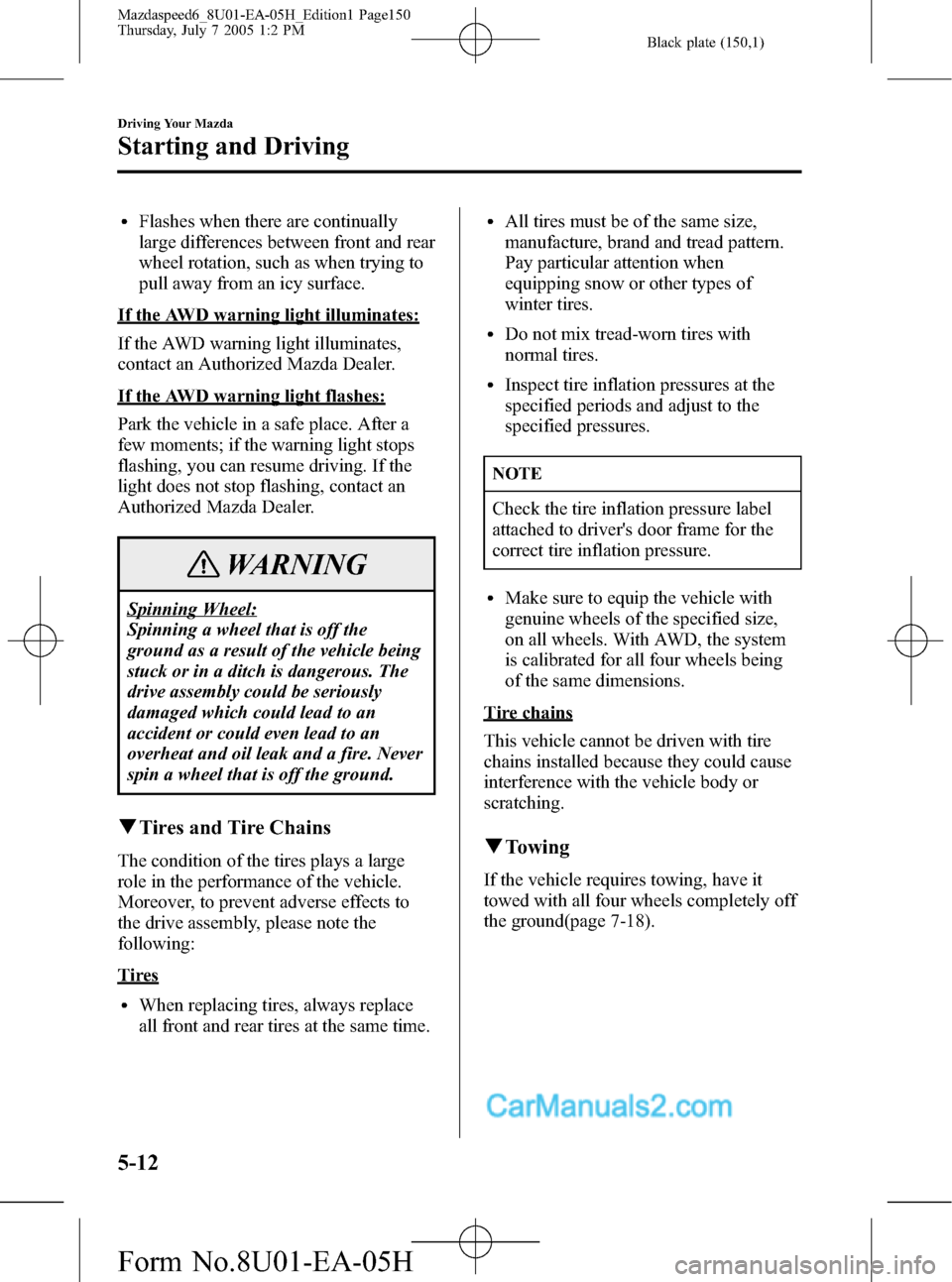
Black plate (150,1)
lFlashes when there are continually
large differences between front and rear
wheel rotation, such as when trying to
pull away from an icy surface.
If the AWD warning light illuminates:
If the AWD warning light illuminates,
contact an Authorized Mazda Dealer.
If the AWD warning light flashes:
Park the vehicle in a safe place. After a
few moments; if the warning light stops
flashing, you can resume driving. If the
light does not stop flashing, contact an
Authorized Mazda Dealer.
WARNING
Spinning Wheel:
Spinning a wheel that is off the
ground as a result of the vehicle being
stuck or in a ditch is dangerous. The
drive assembly could be seriously
damaged which could lead to an
accident or could even lead to an
overheat and oil leak and a fire. Never
spin a wheel that is off the ground.
qTires and Tire Chains
The condition of the tires plays a large
role in the performance of the vehicle.
Moreover, to prevent adverse effects to
the drive assembly, please note the
following:
Tires
lWhen replacing tires, always replace
all front and rear tires at the same time.
lAll tires must be of the same size,
manufacture, brand and tread pattern.
Pay particular attention when
equipping snow or other types of
winter tires.
lDo not mix tread-worn tires with
normal tires.
lInspect tire inflation pressures at the
specified periods and adjust to the
specified pressures.
NOTE
Check the tire inflation pressure label
attached to driver's door frame for the
correct tire inflation pressure.
lMake sure to equip the vehicle with
genuine wheels of the specified size,
on all wheels. With AWD, the system
is calibrated for all four wheels being
of the same dimensions.
Tire chains
This vehicle cannot be driven with tire
chains installed because they could cause
interference with the vehicle body or
scratching.
qTowing
If the vehicle requires towing, have it
towed with all four wheels completely off
the ground(page 7-18).
5-12
Driving Your Mazda
Starting and Driving
Mazdaspeed6_8U01-EA-05H_Edition1 Page150
Thursday, July 7 2005 1:2 PM
Form No.8U01-EA-05H
Page 234 of 354
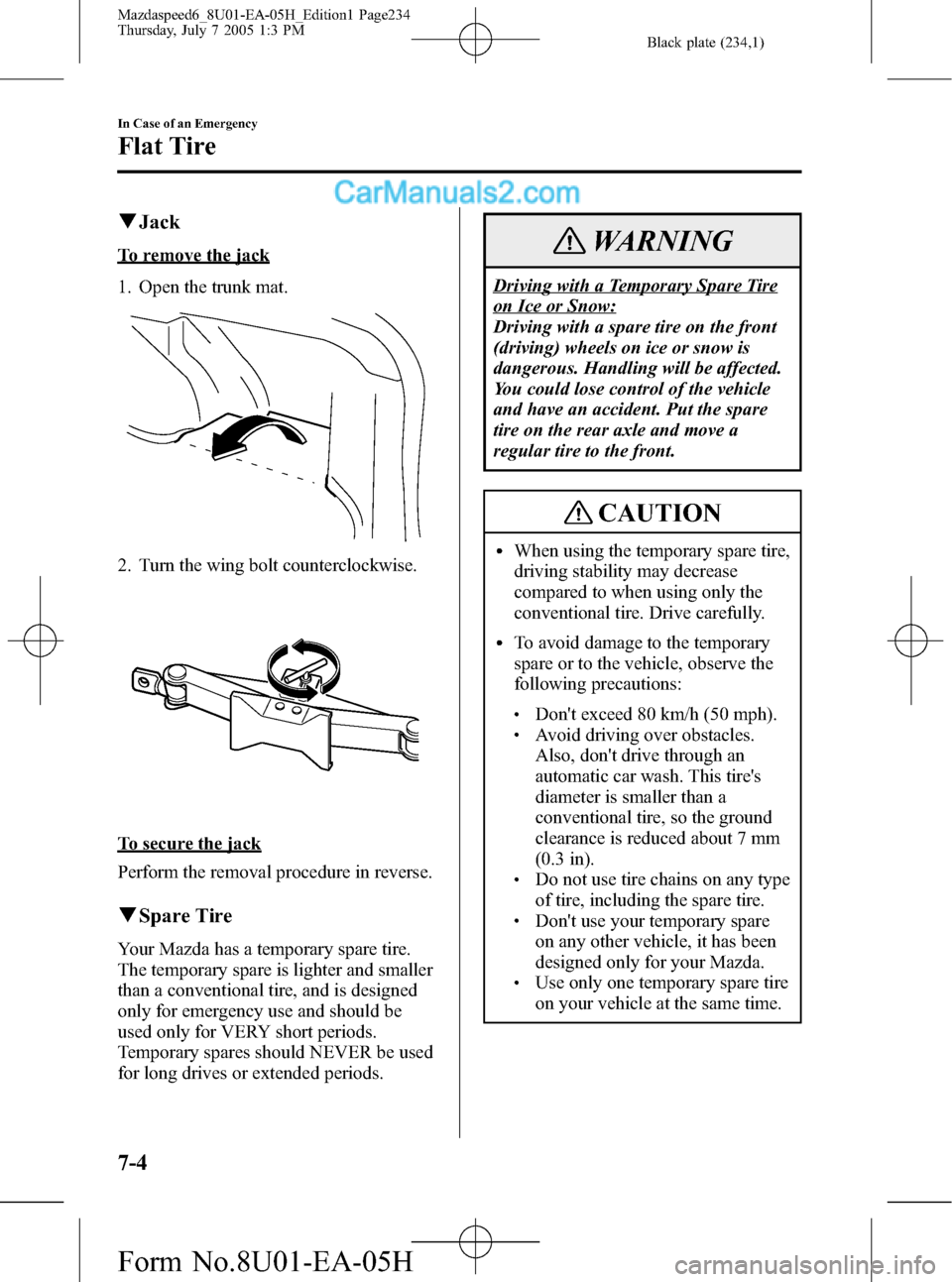
Black plate (234,1)
qJack
To remove the jack
1. Open the trunk mat.
2. Turn the wing bolt counterclockwise.
To secure the jack
Perform the removal procedure in reverse.
qSpare Tire
Your Mazda has a temporary spare tire.
The temporary spare is lighter and smaller
than a conventional tire, and is designed
only for emergency use and should be
used only for VERY short periods.
Temporary spares should NEVER be used
for long drives or extended periods.
WARNING
Driving with a Temporary Spare Tire
on Ice or Snow:
Driving with a spare tire on the front
(driving) wheels on ice or snow is
dangerous. Handling will be affected.
You could lose control of the vehicle
and have an accident. Put the spare
tire on the rear axle and move a
regular tire to the front.
CAUTION
lWhen using the temporary spare tire,
driving stability may decrease
compared to when using only the
conventional tire. Drive carefully.
lTo avoid damage to the temporary
spare or to the vehicle, observe the
following precautions:
lDon't exceed 80 km/h (50 mph).lAvoid driving over obstacles.
Also, don't drive through an
automatic car wash. This tire's
diameter is smaller than a
conventional tire, so the ground
clearance is reduced about 7 mm
(0.3 in).
lDo not use tire chains on any type
of tire, including the spare tire.
lDon't use your temporary spare
on any other vehicle, it has been
designed only for your Mazda.
lUse only one temporary spare tire
on your vehicle at the same time.
7-4
In Case of an Emergency
Flat Tire
Mazdaspeed6_8U01-EA-05H_Edition1 Page234
Thursday, July 7 2005 1:3 PM
Form No.8U01-EA-05H
Page 256 of 354
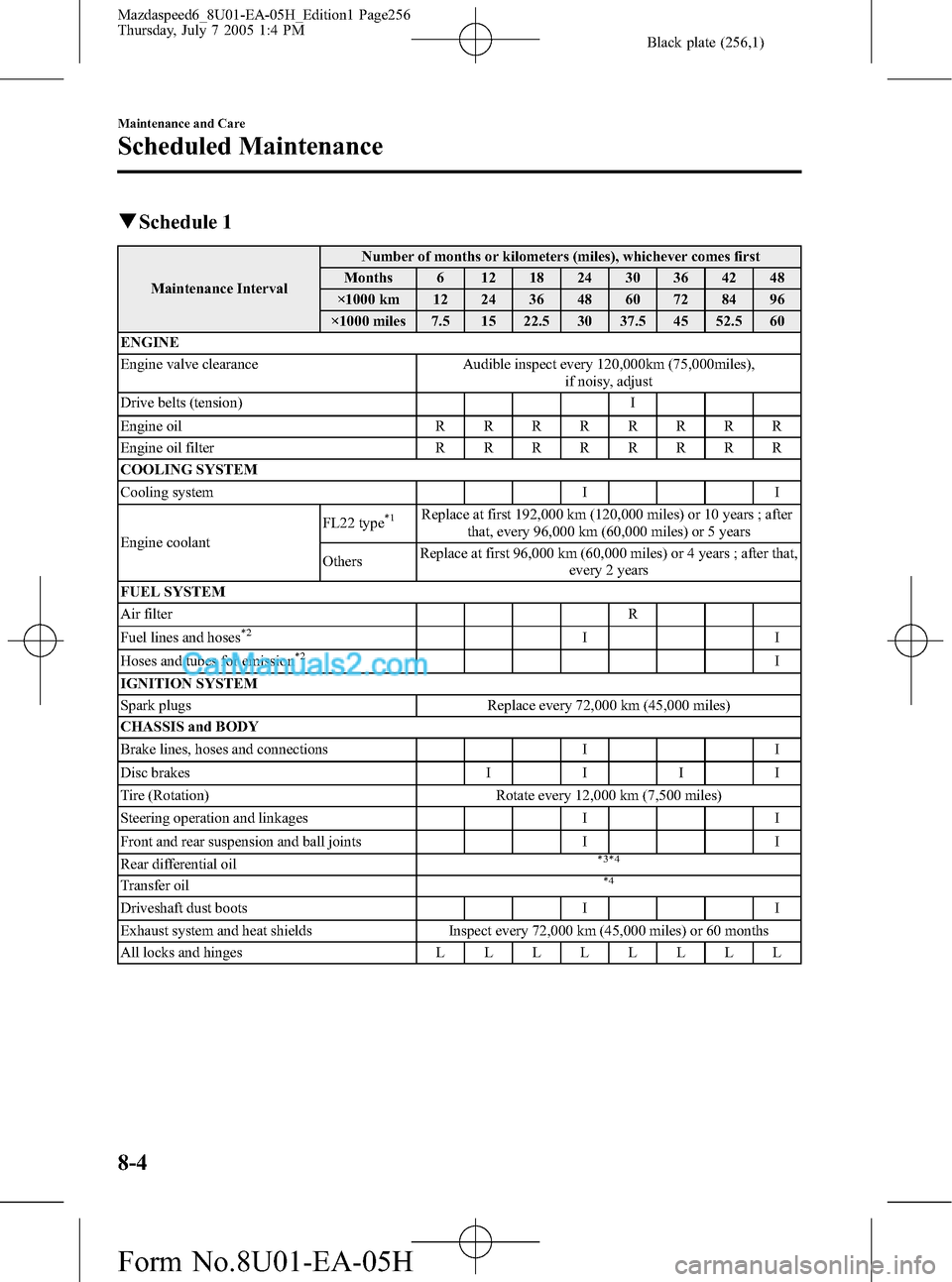
Black plate (256,1)
qSchedule 1
Maintenance IntervalNumber of months or kilometers (miles), whichever comes first
Months 6 12 18 24 30 36 42 48
×1000 km 12 24 36 48 60 72 84 96
×1000 miles 7.5 15 22.5 30 37.5 45 52.5 60
ENGINE
Engine valve clearance Audible inspect every 120,000km (75,000miles),
if noisy, adjust
Drive belts (tension) I
Engine oilRRRRRRRR
Engine oil filterRRRRRRRR
COOLING SYSTEM
Cooling system I I
Engine coolantFL22 type
*1Replace at first 192,000 km (120,000 miles) or 10 years ; after
that, every 96,000 km (60,000 miles) or 5 years
OthersReplace at first 96,000 km (60,000 miles) or 4 years ; after that,
every 2 years
FUEL SYSTEM
Air filter R
Fuel lines and hoses
*2II
Hoses and tubes for emission*2I
IGNITION SYSTEM
Spark plugs Replace every 72,000 km (45,000 miles)
CHASSIS and BODY
Brake lines, hoses and connections I I
Disc brakesIIII
Tire (Rotation) Rotate every 12,000 km (7,500 miles)
Steering operation and linkages I I
Front and rear suspension and ball joints I I
Rear differential oil
*3*4
Transfer oil*4
Driveshaft dust boots I I
Exhaust system and heat shields Inspect every 72,000 km (45,000 miles) or 60 months
All locks and hingesLLLLLLLL
8-4
Maintenance and Care
Scheduled Maintenance
Mazdaspeed6_8U01-EA-05H_Edition1 Page256
Thursday, July 7 2005 1:4 PM
Form No.8U01-EA-05H
Page 259 of 354
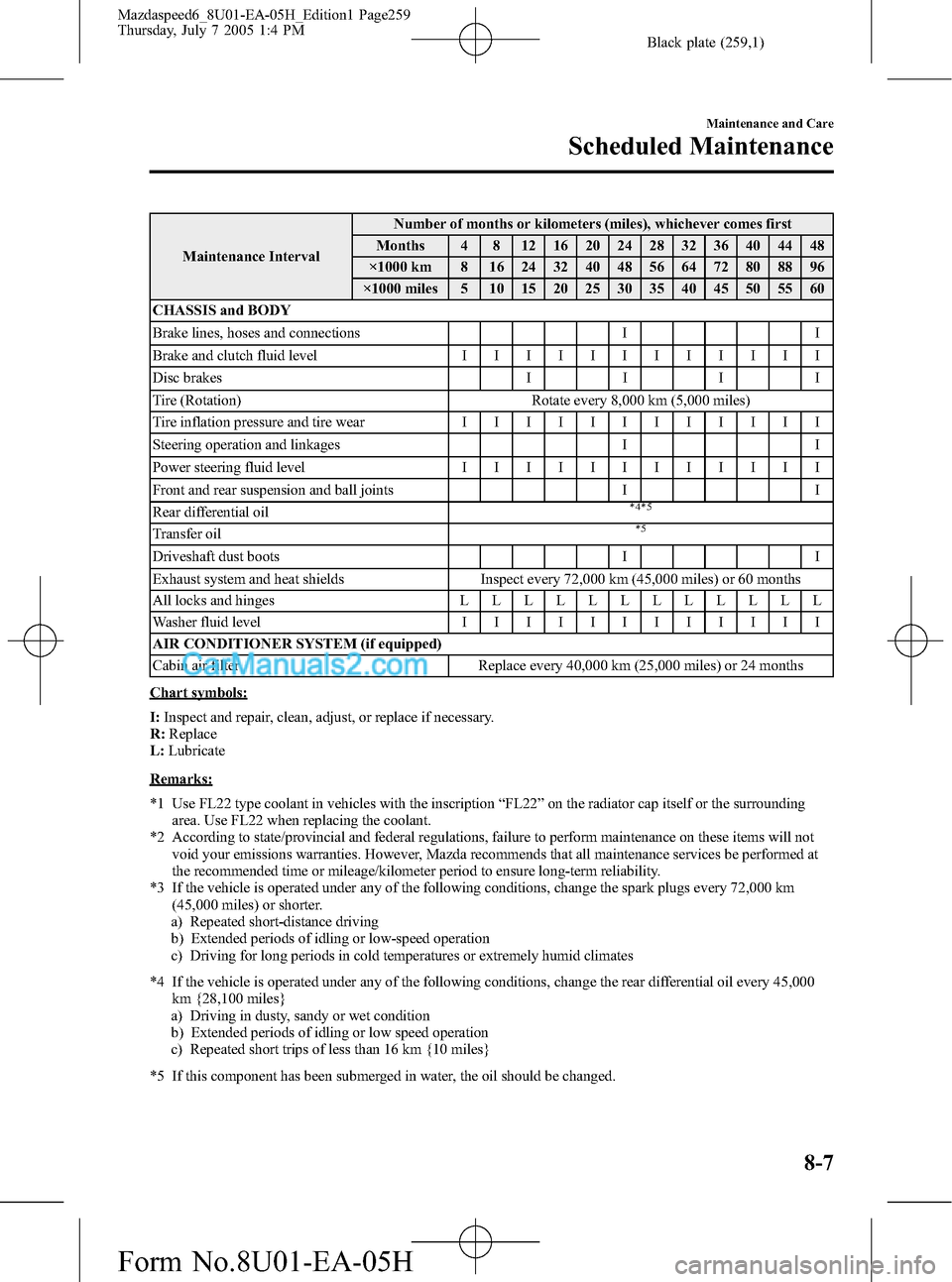
Black plate (259,1)
Maintenance IntervalNumber of months or kilometers (miles), whichever comes first
Months 4 8 12 16 20 24 28 32 36 40 44 48
×1000 km 8 16 24 32 40 48 56 64 72 80 88 96
×1000 miles 5 10 15 20 25 30 35 40 45 50 55 60
CHASSIS and BODY
Brake lines, hoses and connections I I
Brake and clutch fluid levelIIIIIIIIIIII
Disc brakesIIII
Tire (Rotation) Rotate every 8,000 km (5,000 miles)
Tire inflation pressure and tire wearIIIIIIIIIIII
Steering operation and linkages I I
Power steering fluid levelIIIIIIIIIIII
Front and rear suspension and ball joints I I
Rear differential oil
*4*5
Transfer oil*5
Driveshaft dust boots I I
Exhaust system and heat shields Inspect every 72,000 km (45,000 miles) or 60 months
All locks and hingesLLLLLLLLLLLL
Washer fluid levelIIIIIIIIIIII
AIR CONDITIONER SYSTEM (if equipped)
Cabin air filter Replace every 40,000 km (25,000 miles) or 24 months
Chart symbols:
I:Inspect and repair, clean, adjust, or replace if necessary.
R:Replace
L:Lubricate
Remarks:
*1 Use FL22 type coolant in vehicles with the inscription“FL22”on the radiator cap itself or the surrounding
area. Use FL22 when replacing the coolant.
*2 According to state/provincial and federal regulations, failure to perform maintenance on these items will not
void your emissions warranties. However, Mazda recommends that all maintenance services be performed at
the recommended time or mileage/kilometer period to ensure long-term reliability.
*3 If the vehicle is operated under any of the following conditions, change the spark plugs every 72,000 km
(45,000 miles) or shorter.
a) Repeated short-distance driving
b) Extended periods of idling or low-speed operation
c) Driving for long periods in cold temperatures or extremely humid climates
*4 If the vehicle is operated under any of the following conditions, change the rear differential oil every 45,000
km {28,100 miles}
a) Driving in dusty, sandy or wet condition
b) Extended periods of idling or low speed operation
c) Repeated short trips of less than 16 km {10 miles}
*5 If this component has been submerged in water, the oil should be changed.
Maintenance and Care
Scheduled Maintenance
8-7
Mazdaspeed6_8U01-EA-05H_Edition1 Page259
Thursday, July 7 2005 1:4 PM
Form No.8U01-EA-05H
Page 278 of 354
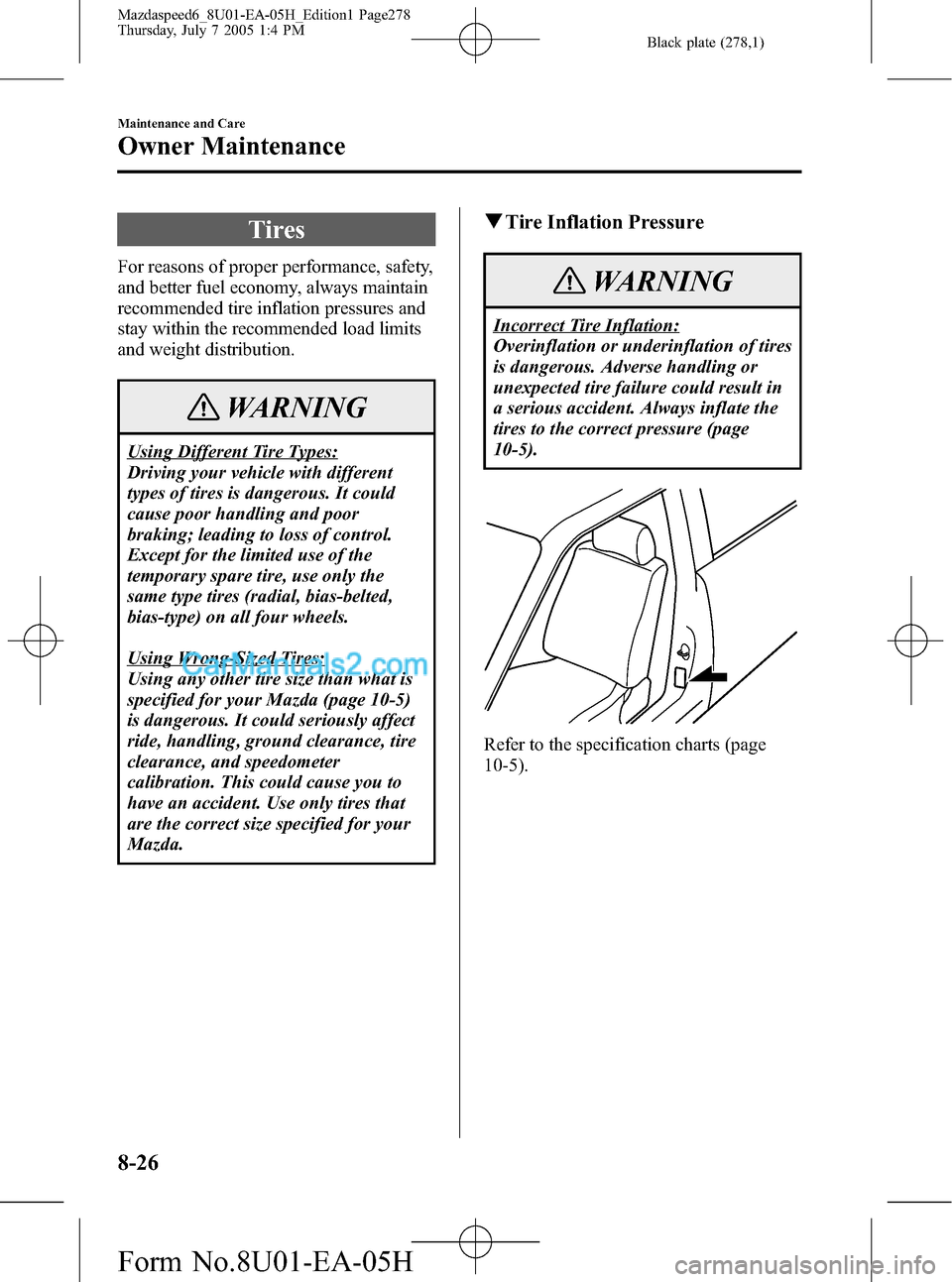
Black plate (278,1)
Tires
For reasons of proper performance, safety,
and better fuel economy, always maintain
recommended tire inflation pressures and
stay within the recommended load limits
and weight distribution.
WARNING
Using Different Tire Types:
Driving your vehicle with different
types of tires is dangerous. It could
cause poor handling and poor
braking; leading to loss of control.
Except for the limited use of the
temporary spare tire, use only the
same type tires (radial, bias-belted,
bias-type) on all four wheels.
Using Wrong-Sized Tires:
Using any other tire size than what is
specified for your Mazda (page 10-5)
is dangerous. It could seriously affect
ride, handling, ground clearance, tire
clearance, and speedometer
calibration. This could cause you to
have an accident. Use only tires that
are the correct size specified for your
Mazda.
qTire Inflation Pressure
WARNING
Incorrect Tire Inflation:
Overinflation or underinflation of tires
is dangerous. Adverse handling or
unexpected tire failure could result in
a serious accident. Always inflate the
tires to the correct pressure (page
10-5).
Refer to the specification charts (page
10-5).
8-26
Maintenance and Care
Owner Maintenance
Mazdaspeed6_8U01-EA-05H_Edition1 Page278
Thursday, July 7 2005 1:4 PM
Form No.8U01-EA-05H
Page 281 of 354
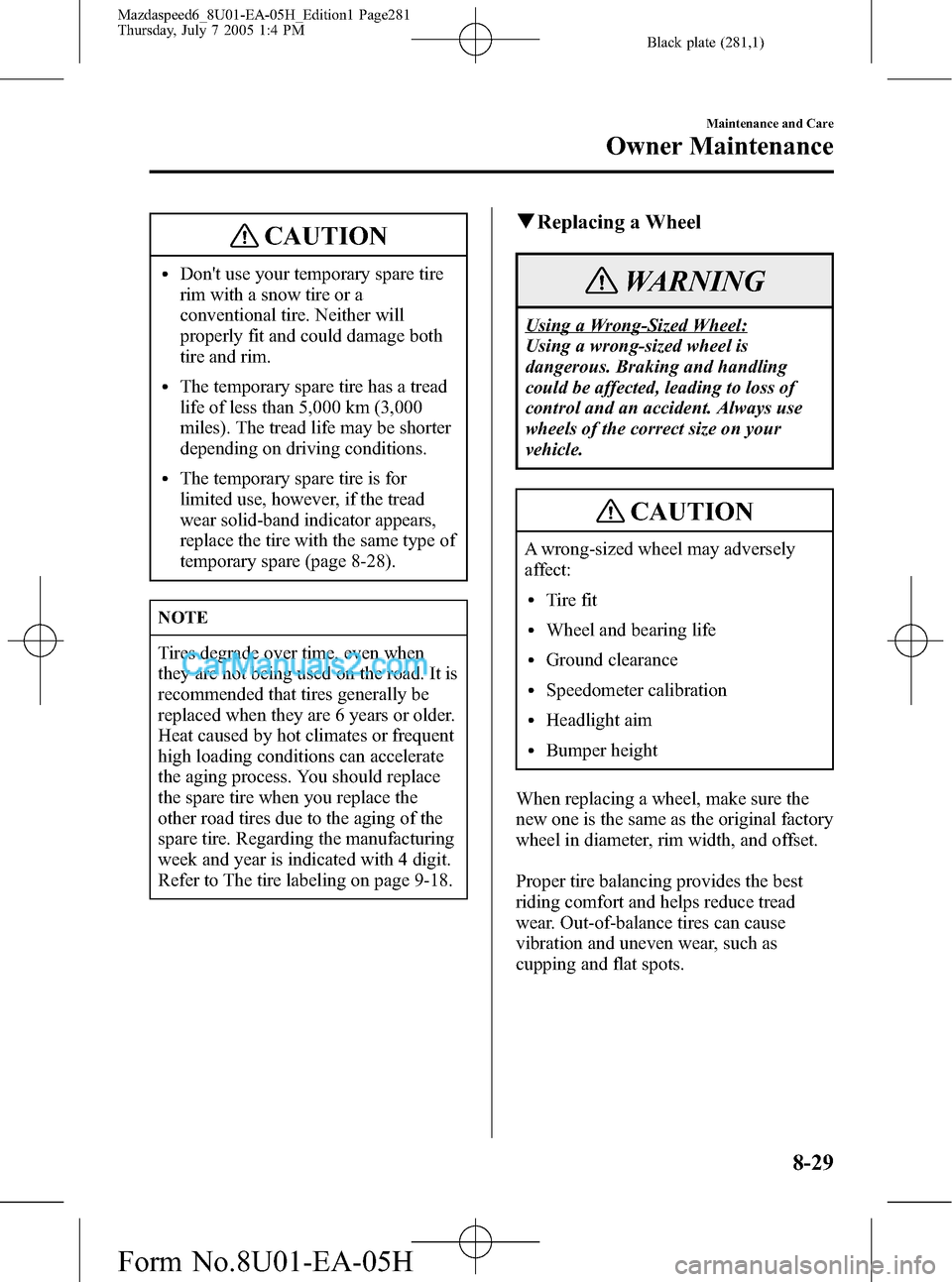
Black plate (281,1)
CAUTION
lDon't use your temporary spare tire
rim with a snow tire or a
conventional tire. Neither will
properly fit and could damage both
tire and rim.
lThe temporary spare tire has a tread
life of less than 5,000 km (3,000
miles). The tread life may be shorter
depending on driving conditions.
lThe temporary spare tire is for
limited use, however, if the tread
wear solid-band indicator appears,
replace the tire with the same type of
temporary spare (page 8-28).
NOTE
Tires degrade over time, even when
they are not being used on the road. It is
recommended that tires generally be
replaced when they are 6 years or older.
Heat caused by hot climates or frequent
high loading conditions can accelerate
the aging process. You should replace
the spare tire when you replace the
other road tires due to the aging of the
spare tire. Regarding the manufacturing
week and year is indicated with 4 digit.
Refer to The tire labeling on page 9-18.
qReplacing a Wheel
WARNING
Using a Wrong-Sized Wheel:
Using a wrong-sized wheel is
dangerous. Braking and handling
could be affected, leading to loss of
control and an accident. Always use
wheels of the correct size on your
vehicle.
CAUTION
A wrong-sized wheel may adversely
affect:
lTire fit
lWheel and bearing life
lGround clearance
lSpeedometer calibration
lHeadlight aim
lBumper height
When replacing a wheel, make sure the
new one is the same as the original factory
wheel in diameter, rim width, and offset.
Proper tire balancing provides the best
riding comfort and helps reduce tread
wear. Out-of-balance tires can cause
vibration and uneven wear, such as
cupping and flat spots.
Maintenance and Care
Owner Maintenance
8-29
Mazdaspeed6_8U01-EA-05H_Edition1 Page281
Thursday, July 7 2005 1:4 PM
Form No.8U01-EA-05H
Page 301 of 354

Black plate (301,1)
9
Customer Information and Reporting
Safety Defects
Important consumer information including warranties and add-on equipment.
Customer Assistance ............................... 9-2
Customer Assistance (U.S.A.) ............ 9-2
Customer Assistance (Canada) ........... 9-4
Customer Assistance (Puerto Rico) .... 9-7
Mazda Importer/Distributors ................. 9-8
Importer/Distributor ............................ 9-8
Distributor in Each Area ..................... 9-8
Warranty .................................................. 9-9
Warranties for Your Mazda ................. 9-9
Outside the United States .................. 9-10
Outside Canada ................................. 9-11
Registering Your Vehicle in A Foreign
Country (Except United States and
Canada) ............................................. 9-12
Add-On Non-Genuine Parts and
Accessories ....................................... 9-13
Cell Phones ............................................. 9-14
Cell Phones Warning ......................... 9-14
Type Approval of Equipment ............... 9-15
Type Approval of Equipment ............ 9-15
Uniform Tire Quality Grading System
(UTQGS) ................................................ 9-16
Uniform Tire Quality Grading System
(UTQGS) .......................................... 9-16
Tire Information (U.S.A.) ..................... 9-18
Tire Labeling ..................................... 9-18
Location of the Tire Label
(Placard) ............................................ 9-24
Tire Maintenance .............................. 9-27
Vehicle Loading ................................ 9-30
Steps for Determining the Correct Load
Limit: ................................................ 9-37Reporting Safety Defects ....................... 9-38
Reporting Safety Defects (U.S.A.) .... 9-38
Reporting Safety Defects (Canada) ... 9-39
Service Publications .............................. 9-40
Service Publications .......................... 9-40
9-1
Mazdaspeed6_8U01-EA-05H_Edition1 Page301
Thursday, July 7 2005 1:4 PM
Form No.8U01-EA-05H
Page 321 of 354
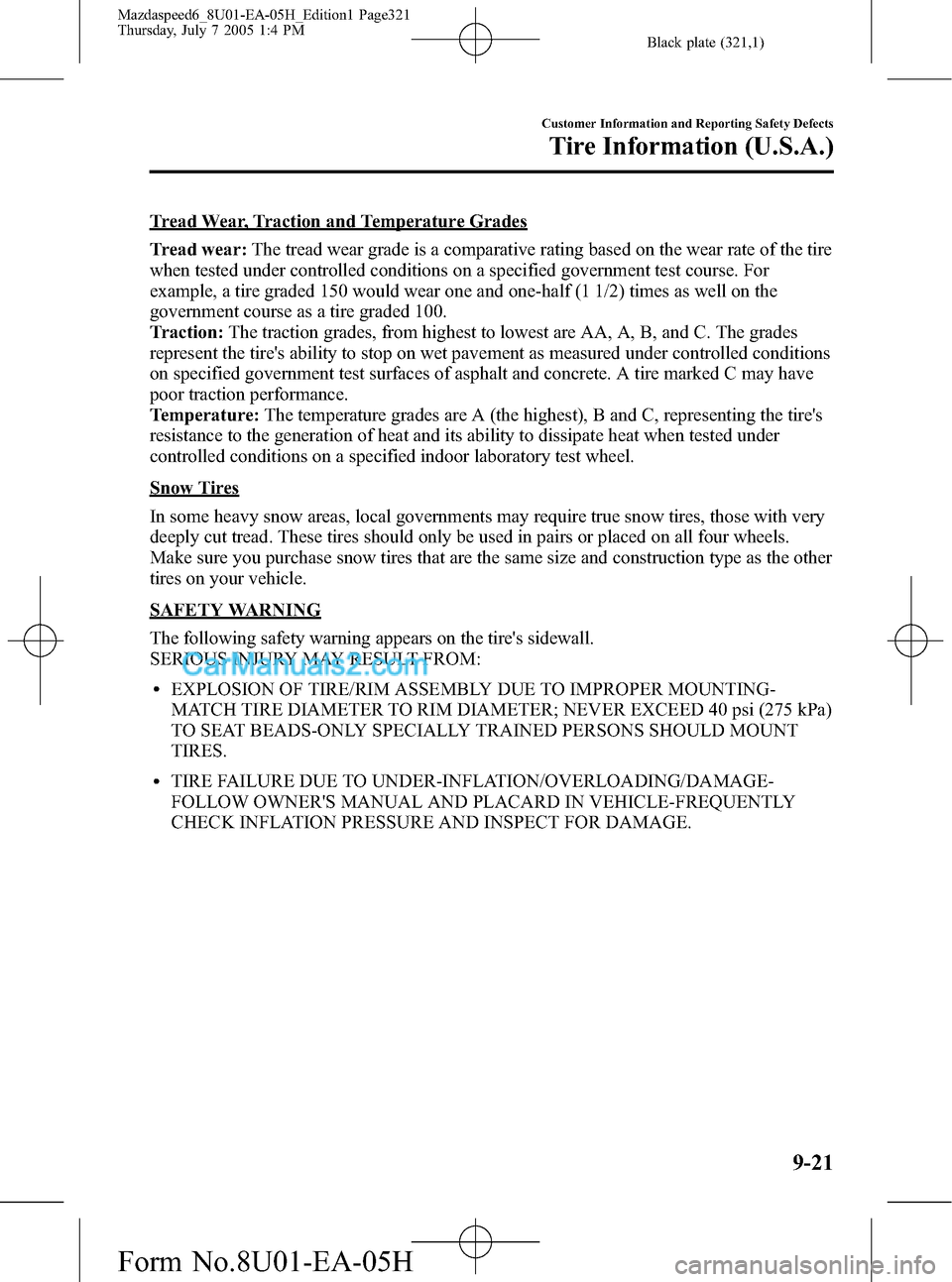
Black plate (321,1)
Tread Wear, Traction and Temperature Grades
Tread wear:The tread wear grade is a comparative rating based on the wear rate of the tire
when tested under controlled conditions on a specified government test course. For
example, a tire graded 150 would wear one and one-half (1 1/2) times as well on the
government course as a tire graded 100.
Traction:The traction grades, from highest to lowest are AA, A, B, and C. The grades
represent the tire's ability to stop on wet pavement as measured under controlled conditions
on specified government test surfaces of asphalt and concrete. A tire marked C may have
poor traction performance.
Temperature:The temperature grades are A (the highest), B and C, representing the tire's
resistance to the generation of heat and its ability to dissipate heat when tested under
controlled conditions on a specified indoor laboratory test wheel.
Snow Tires
In some heavy snow areas, local governments may require true snow tires, those with very
deeply cut tread. These tires should only be used in pairs or placed on all four wheels.
Make sure you purchase snow tires that are the same size and construction type as the other
tires on your vehicle.
SAFETY WARNING
The following safety warning appears on the tire's sidewall.
SERIOUS INJURY MAY RESULT FROM:
lEXPLOSION OF TIRE/RIM ASSEMBLY DUE TO IMPROPER MOUNTING-
MATCH TIRE DIAMETER TO RIM DIAMETER; NEVER EXCEED 40 psi (275 kPa)
TO SEAT BEADS-ONLY SPECIALLY TRAINED PERSONS SHOULD MOUNT
TIRES.
lTIRE FAILURE DUE TO UNDER-INFLATION/OVERLOADING/DAMAGE-
FOLLOW OWNER'S MANUAL AND PLACARD IN VEHICLE-FREQUENTLY
CHECK INFLATION PRESSURE AND INSPECT FOR DAMAGE.
Customer Information and Reporting Safety Defects
Tire Information (U.S.A.)
9-21
Mazdaspeed6_8U01-EA-05H_Edition1 Page321
Thursday, July 7 2005 1:4 PM
Form No.8U01-EA-05H